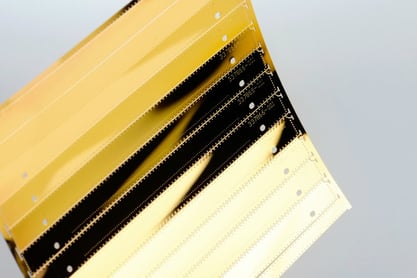Technology meets process: customized inkjet nozzle plates in 5 steps
Apr 26, 2016 10:00:00 AM By Wim Gravestijn The most critical component of an inkjet print head is the inkjet nozzle plate. Why? Because it determines the resulting printing performance of the whole system.
The most critical component of an inkjet print head is the inkjet nozzle plate. Why? Because it determines the resulting printing performance of the whole system.
Therefore, when trusting others with the production of the nozzle plate, technology as well as process is the most crucial factor. Electroformed nozzle plates remain preferred by the leading players in the industry because of unsurpassed jetting straightness, ultra-precise hole geometry as well as superior chemical and mechanical stability, which none of other fabrication methods could achieve.
As the industry leading specialist in electroforming and over 25 years of inkjet experience, Veco offers customized top quality inkjet nozzle plates. Below we give an example of our process to manufacture an inkjet nozzle plate in 5 steps, which ensures our customers that we meet every specific need.
1. A well controlled process as a solid base
After determining requirements of the customer in a technical discussion, the production process can start.
First, a custom metal plate (mandrel) with a patterned photo resist layer on top, onto which the metal will be grown during the electroforming process is made. This step is very important, because the final dimensions of an electroformed part are directly influenced by the accuracy of the mandrel.
Before starting the process, the mold is strictly measured, determining the shape and size of the holes in the inkjet nozzle plate. The holes in the produced nozzle plate will have the exact dimension the customer requires, with no flats or blockings. Variety of diameters of each nozzle can be as good as within ± 1µm.
A well controlled photolithography process as a solid base will tackle any unwelcome surprises.
2. Using the right method to control accuracy
After mandrel making, it is time for the electroforming process.
Usually, the overgrowth method is applied to shape the apertures. This means simply growing the metal over the thin layer resist, determining the size and shape of the apertures very accurately.
3. Protecting the plated product
After the electroforming process, we can apply a gold or palladium-nickel coating to protect the inkjet nozzle plate and prevent corrosion. Another round of process control is done subsequently to make sure the quality of the process is consistent.
4. Cleaning and visual inspection
After electroforming and plating are done, every single hole is checked with an image analyzer. The image analyzer measures all the holes within submicron accuracy. It also detects any disturbance of the holes which might lead to a bad printing performance.
After this the products are ultrasonically cleaned and packaged under clean room conditions before shipping.
5. Traceability of nozzle plates by laser marking
Additionally, we are also able to provide the customer with unique and valuable tracking data. It is possible to laser mark any individual product with a text or code. These codes can be read by our customer with scanning equipment and are vital for traceability and constant improvement. Customers can also read data regarding specifications of the hole, for example size and pattern. This helps customers determine the effect of a certain inkjet nozzle on the printed pattern, helping them learn and improve!
Electroforming provides unmatched jetting performance, ultra-precise hole geometry and superior chemical and mechanical stability. Combining this with a customer driven approach, and what you'll find is a top quality custom inkjet nozzle plate which enables unsurpassed printing performance, fully customized to your demands.
